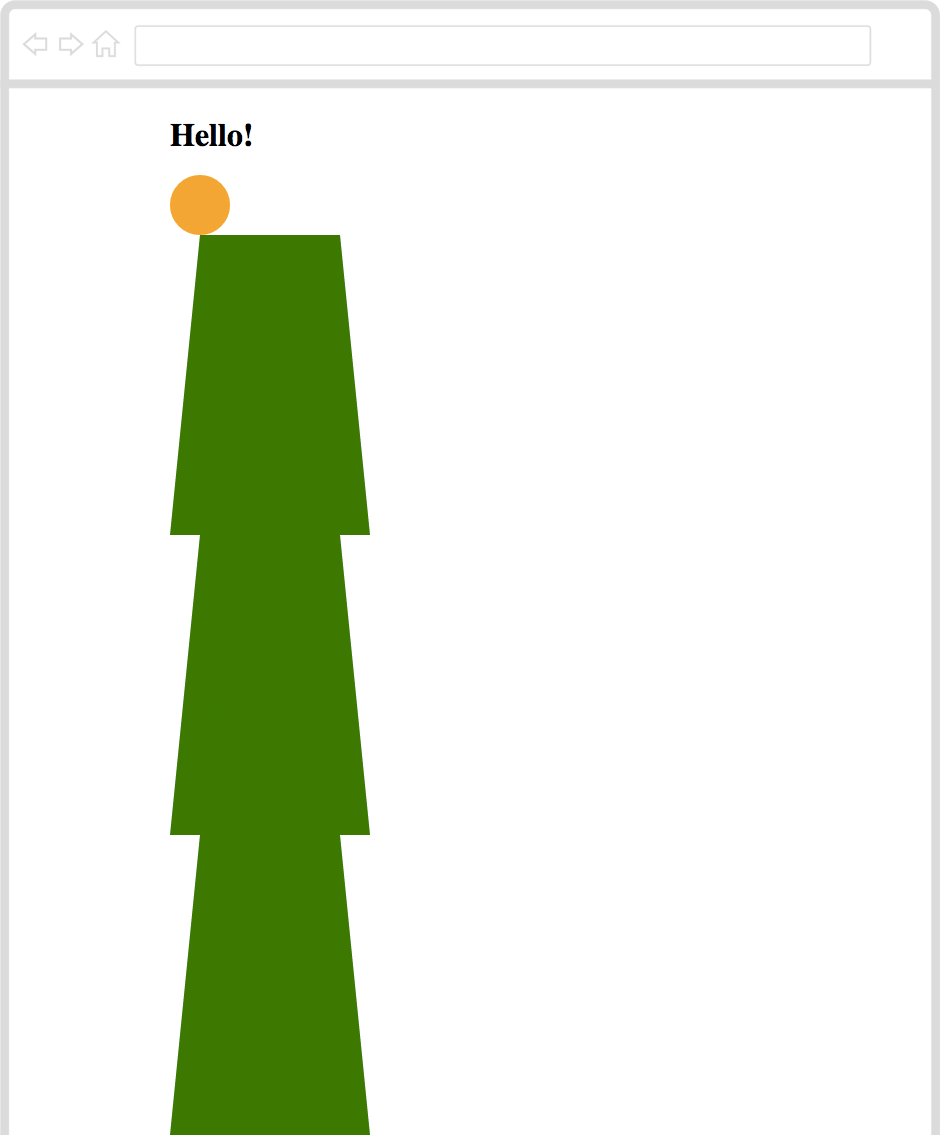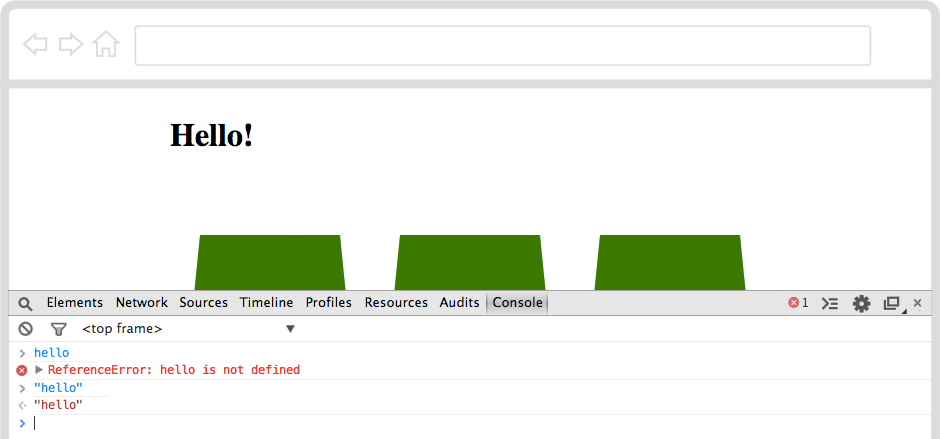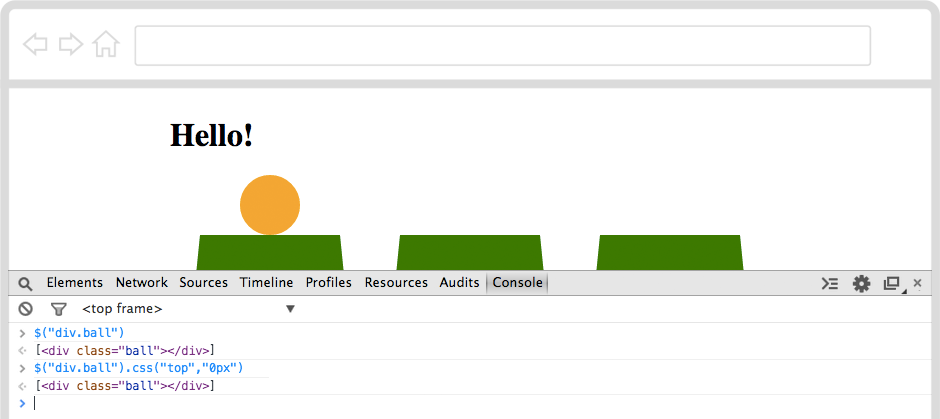Introduction
Under which cup is the the ball?
Can you code your own Cups & Balls game, so that anyone on the Web can enjoy playing it?

Step 1: Are you ready?
Activity Checklist
Here is a list of things to check before you dig into your game.
- Open your code editor. Do you have an app on your computer to write your code?
- NO. Talk to your teacher or volunteer about installing a code editor: we recommend Sublime Text 2.
- YES. Great, move on.
Create a new file.
Here is the skeleton of an HTML1 document.
Copy-paste it into your new file.
<!DOCTYPE html>
<html>
<head>
<title>Code Club Cups</title>
<style>
* { box-sizing: border-box; position: relative; }
html, body { height: 100%; }
body
{
max-width: 600px;
margin: 0 auto;
}
</style>
</head>
<body>
<h1>HELLO!</h1>
</body>
</html>- Save your file. You can save it as whatever you want to call it. Just remember to end your file name with
.htmlso that your computer knows it’s an HTML file. For instance, you could call your filecups-balls-game.html. Can you think of a less boring name? - Do you know where your HTML file has gone?
- NO. Ok, it’s somewhere on your computer. Can you find it?
- YES. Good, let’s move on.
- Open your browser2.
- From your browser, open your HTML file . Does it say
HELLO!? - Go back to the code editor. Can you change the
HELLO!text to the name of your game? - Save your HTML file.
- Back to your browser, can you refresh3 the page where you opened your HTML file?
- Great! Now you’ve got your tools ready: code editor to write your code, browser to debug4 your code.
Step 2: How do you make a ball?
Activity Checklist
Let’s throw a ball into your HTML document. How?
<div class="ball"></div>- Copy-paste this code inside your HTML document. Where? Anywhere between the
<body>opening tag and the</body>closing tag.
Since there is no specific <ball> element in HTML, you can use the generic <div> instead. It may be a bad word in English, but it’s a very useful building block in the HTML language.
Use <div> with a meaningful class name. You could call it whatever you like, for example “spherical object”, “barking dog” or “tooth-brush”: class names are entirely up to you. Since we’re making a ball, it makes sense to just call it “ball”.
- Save, go to your browser and refresh the page. Do you see a ball?
No ball. That’s because your <div class="ball"></div> has no size.
You can use CSS5 to give the ball some dimension.
div.ball
{
width: 60px;
height: 60px;
background-color: orange;
} - Copy-paste this code into your HTML document. Where? Anywhere between the
<style>opening tag and the</style>closing tag.
See that .ball? It’s a shortcut for [class="ball"]
In CSS . stands for class
For example, you can write div.ball instead of div[class="ball"]
Do you like shortcuts?
Challenge
Using your browser’s Inspector6, can you work out what those CSS rules do?
Now that you have an orange block, can you use the
border-radiusCSS property to turn it into a circle?

Step 3: How do you make a cup?
Activity Checklist
To make a ball, you made a square HTML block, and chiseled its corners away until it became well round.
You are a Web sculptor!
To make a cup, you can carve a rectangle block into a trapezium.
Do you know what a trapezium is? It’s a wonky rectangle, where only two sides are parallel.
<div class="trapezium"></div>- Copy-paste this code inside your HTML document, after
<div class="ball"></div>and before the</body>closing tag.
As you know, just classifying your <div> as a trapezium won’t make it look like one.
You need CSS to give your <div> that wonky shape.
.trapezium
{
width: 200px;
border-bottom: 300px solid green;
border-left: 30px solid transparent;
}- Copy-paste this code into your HTML document. Where? Anywhere between the
<style>opening tag and the</style>closing tag.
See that .trapezium? It’s a shortcut for [class="trapezium"]
Instead of setting a height you can use borders to create shapes with CSS.
- Save, go to your browser and refresh the page. What do you see?

Challenge
- Right-click on your green trapezium, then choose Inspect Element to inspect it.
- Play around with
border-bottomandborder-leftto change the shape of your trapezium. - Can you add a new line for
border-rightand make your trapezium look like a cup turned upside down?

Step 4: How do you make many cups?
Activity Checklist
You just cut a really nice cup!
Well, are you sure it’s a cup? At the moment, it is a <div> classified as trapezium.
- Can you add an appropriate class name to your
<div class="trapezium"></div>so that your browser knows it’s not just a trapezium, but also a cup?
You see, you can add as many class names as you wish to your HTML elements. For example, you can have one class name to describe the shape of your element (trapezium) and another class name to describe the type of object your element represents (cup).
<div class="trapezium cup"></div>Now, a game with only one cup is not really fun to play, is it? Should we make another two cups then?
- Can you make another two trapezium cup elements in your HTML document?
You can copy-paste the first one, to save yourself some typing.
- Save, go to your browser and refresh the page. What do you see?

Challenge
The cups are stuck on top of each other. That’s because your browser likes to pile HTML blocks up.
With CSS, you can tell your browser to put all cups next to each other.
Can you add
float: left;inside a new.cupCSS rule?Save, go to your browser and refresh the page. What do you see?

Step 5: How do you hide the ball?
Activity Checklist
Now all cups look grounded. According to your browser though, the cups are floating. Bizzarre way to put it, don’t you think?
And that ball, doesn’t it look like it’s about to fall? Should we move the ball?
Add
left: 70px;inside yourdiv.ballCSS rule.Save, go to your browser and refresh the page. Did the ball move?
Your browser offset the ball 70px from the left where it was before.
Challenge
- Can you move the ball down so that it’s hidden by the first cup?

Step 6: How do you show the ball?
Activity Checklist
You hid the ball. Good trick, magician!
Using your CSS wizardry, can you lift the cups when you click them?
.cup:active
{
}When you click on an element, CSS calls it active.
See that :active after .cup? It means “when any cup element is being clicked”.
Challenge
- Can you offset the cup from the bottom, so that when clicked it lifts up?

Step 7: How do you shuffle the ball?
Activity Checklist
Now comes the tricky part, wizard!
How do you shuffle the ball, so that it’s not always under the same cup?
- Play around with the value of
leftin thediv.ballCSS rule.
For example, if you set it to left: 270px; the ball will go under the second cup.
- Can you move the ball under the third cup?

Now you know how to shuffle the ball from one cup to another.
Step 8: What about getting your browser to shuffle the ball for you?
Activity Checklist
Yes, you can! With JavaScript7.
If you speak JavaScript to your browser, it will do maths for you, move things around, make them appear and disappear, and much more.
There is JavaScript running on your page, right now. Should we play around with it?
- Right-click anywhere on your page, then choose Inspect Element.
- This time, when the Inspector pops up click on Console.
The Console is like a chat with your browser: you can type something into it and your browser will answer straight back.
- Can you say
helloto your browser?

- Press the
Enter8 key. What does your browser reply?

- Can you try again, this time with
"hello"wrapped in"speech marks?

The second time your browser replied politely :)
That’s because in JavaScript texts must be wrapped in " speech marks. Your browser calls “text” a string of characters.
- Can you ask your browser to do some math, for example
3 + 7?

Your browser can talk numbers.
- Can you type in
alert( 3+7 )?
Your browser popped up the result in a new window this time. Did you click OK?
You can use alert() to get your browser to shout things at you.
alert() is one of many functions that your browser can do.
You can write your own functions, to get the browser to make complex things for you. And you can borrow code that other smart people have already made and kindly shared on the Web.
Back to your game
What exactly do you need your browser to do, in order to shuffle that ball?
As you noticed, the ball left offset can be 70px, 270px or 470px to be hidden under the first, second or third cup.
How can you get your browser to
- pick one of those values at random for you
- then move the ball there?
For this time, let’s borrow some code from other smart and kind people. Next time, you’ll write your own functions!
Copy-paste the
underscore.jsfile, from this project’s Resources folder into the folder where you saved your HTML file.Add
<script src="underscore.js"></script>to the<head>of your document. Where? Just before the</head>closing tag.Save, go to your browser and refresh the page.
Right-click anywhere on your page, choose Inspect Element. When the Inspector pops up, click on Console.
You’ve just loaded your browser with a new helper, called Underscore, which gives you plenty of functions to play with.
- Type
_.in the Console

Your browser will suggest you all the functions available from Underscore.
_ is the nickname your browser gives to Underscore.
In JavaScript you can use . to peep inside things.
So _. tells your browser to find Underscore and start looking inside it
- Type in
_.sample( [ "70px", "270px", "470px" ] )and press theEnterkey.
_.sample() is a function to pick a random sample from a list, a bit like picking a random card from a deck.
Your browser will pick one of the three strings that you gave it.
- Press the
↑arrow on your keyboard. That will bring up the last “order” you gave to your browser, so that you don’t have to type it again. - Press the
Enterkey. - Repeat
↑+Entera few times.

Each time your browser will pick one of the three strings, in an unpredictable way.
That’s handy. How can you store that random string?
- Type in
var randomOffset = _.sample( [ "70px", "270px", "470px" ] )and press theEnterkey.
This time, your browser doesn’t answer the random string back to you, but it stores it in a box, or variable9 as it calls it.
It’s no secret though. If you know how to ask, you browser will tell you which string it picked.
- Type in
randomOffsetand press theEnterkey. Does your browser answer which string it picked?
Challenge
Now you know how to ask your browser to pick a random thing for you and store that in a variable. Can you write it down in your HTML document? This way you won’t need to type it every time in the Console.
<script>
// write your JavaScript code under this line
</script>- Copy-paste this code in your HTML document. Where? Just before the
</body>ends. - Inside that
<script>, can you write (or copy-paste) the line of code that picks a random string out of the three and stores it in a variable? - Can you get your browser to
alert()the random string that it picked?
Step 9: How to get your browser to move the ball?
Activity Checklist
Since you got your browser to pick a random string for you, why not ask it to move the ball under a random cup?
For this task, you can use another JavaScript helper called jQuery.
Copy-paste the
jquery.jsfile, from this project’s Resources folder into the folder where you saved your HTML file.Add
<script src="jquery.js"></script>to the<head>of your document. Where? Just before the</head>closing tag.Save, go to your browser and refresh the page.
Right-click anywhere on your page, choose Inspect Element. When the Inspector pops up, click on Console.
Now your browser has two helpers, Underscore nicknamed _, and jQuery nicknamed $.
- Type
$.in the Console.

Your browser will start peeping inside the $ helper.
Now jQuery is useful to select and manipulate things that are already in your HTML document. You can select HTML elements with jQuery in a similar way you do it in CSS.
For example, to select the <body> element, you can write $("body").
How can you select the ball with jQuery? In CSS, you can write div.ball, but what about jQuery?

- Type
$("div.ball").css("top","0px")in the Console and press theEnterkey.

Can you see the ball moved back on top of the cups? Using jQuery you can tell your browser to change CSS rules on the fly!
Let’s read that line of code.
$("div.ball") selects the <div> element classified as ball
.css() is the function to change CSS rules, which asks you two questions
- Which property should I change?
- What value should I use for such property?
For example, .css("top","0px") answers
- Change the
topproperty - Make it
0px
You can use any CSS property with this jQuery function!
- Type
$("div.ball").css("background","blue")and press theEnterkey.
Did the ball turn blue?
Challenge
Good, let’s go back to shuffling, sorcerer.
You summoned your browser to pick a random string for you, and that string represents an offset that the ball can take.
- Can you make your browser use the
randomOffsetto move the ball with jQuery?
Every time you refresh your page, your browser will shout out the value of randomOffset. This is spoiling your trick isn’t it?
See that // at the beginning of // write your JavaScript code under this line?
That is a comment, which your browser will ignore.
To comment a line in JavaScript you simply put // at the beginning, then your browser knows it’s not a command for it to run.
Comments are useful to make notes in your code, to leave notes or cute messages for other coders to read. You can also use them to hide things from the browser, without deleting them.
Can you comment the
alert(randomOffset)line?Save, go to your browser and refresh the page.
Every time you refresh the page, your browser will shuffle the ball under a random cup.
Well done Web magician, now go and challenge your friends!
HTML stands for HyperText Markup Language, which is the language that every website in the World “speaks”. To make a website, you teach your computer how to “translate” your ideas into HTML.↩
What’s a browser? A web browser is a special app that knows how to interpret text files written in HTML. The most popular browsers are Internet Explorer, Google Chrome and Mozilla Firefox.↩
How do you refresh a page in the browser? If you’re on a Windows computer, use the keyboard shortcut CTRL+R (that is, hold the CTRL key down and press the R key once). On a Mac, use ⌘+R.↩
What’s debugging? Debugging means to find and correct glitches in your code. It takes both patience and speed, just like catching a flying bug. Luckily, debugging HTML code in your browser is easy: right-click anywhere on a page and choose Inspect Element. This will pop open your browser’s Inspector, where you can see every page’s source code, styles and much more. When you hover over the source code with your mouse, the corresponding HTML element on the page will light up. When you click on an HTML tag in the source code (left panel), you’ll see all its CSS styles (on the right panel).↩
CSS stands for Cascading Style Sheets and it’s the language you can use to tell your browser to change colours, sizes and many other stylistic aspects of your HTML documents.↩
What’s a browser’s Inspector? In your browser, right-click anywhere on a page and choose Inspect Element. This will pop open your browser’s Inspector, where you can see every page’s source code, styles and much more. When you hover over the source code with your mouse, the corresponding HTML element on the page will light up. When you click on an HTML tag in the source code (left panel), you’ll see all its CSS styles (on the right panel).↩
JavaScript is a programming language that you can use to instruct your browser to do things for you. Just as you used to control adults with screams and tears, you can control your browser with statements written in JavaScript!↩
Which one is the
Enterkey? It’s bigger than the others, usually on the right-hand side of your keyboard, with this ↲ arrow pointing down-left printed on it.↩What’s a variable? The word variable is made by “vary” and “able” and it means “can change”. Variables can store many different things and can change these many times. They are pretty much like boxes where you store thing. You put something in a variable, and then grab it later when you need it.↩


